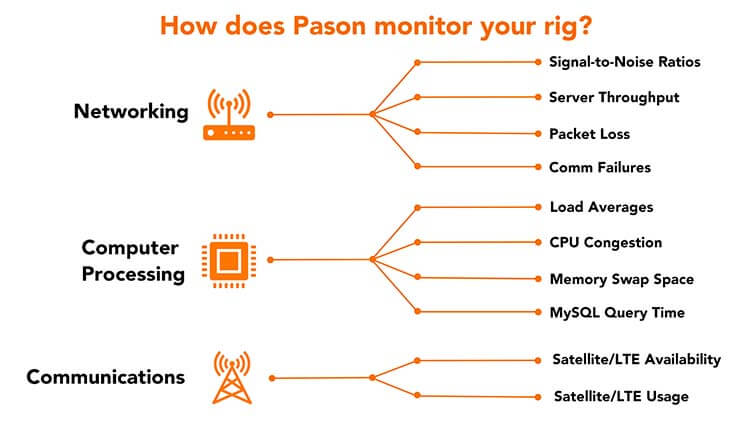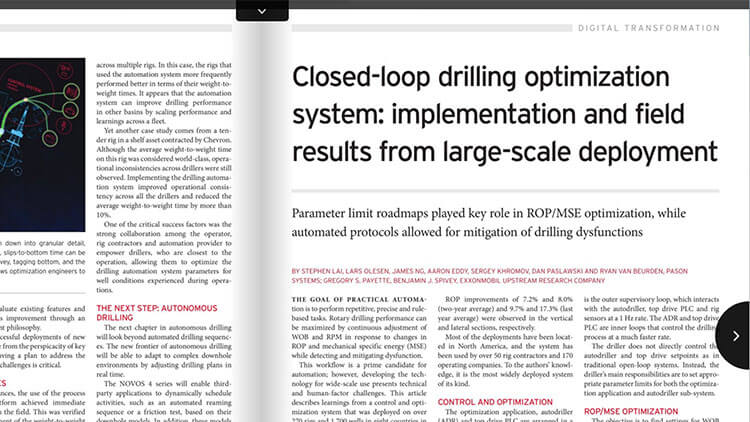Technology news

Drilling intelligence
Method and System for Performing Automated Drilling of a Wellbore
September 8, 2020
Method and System for Performing Automated Drilling of a Wellbore
PATENT: Published on United States Patent, September 8, 2020
Methods, systems, and techniques for performing automated drilling of a wellbore. The wellbore is drilled in response to a first drilling parameter target (such as weight on bit) that includes a first drilling parameter offset modified by a first drilling parameter perturbation signal. A first drilling performance metric (such as rate of penetration) is measured and is indicative of a response of the drilling to the first drilling parameter target. An output of a first objective function is determined using the measured first drilling performance metric. A first correlation between the output of the first objective function and the first drilling parameter perturbation signal, and an integral of the first correlation, are determined. The first drilling parameter target is updated using the integral modified by the first drilling parameter perturbation signal. The wellbore is drilled in response to the updated first drilling parameter target.
Credits
Ng, Choon-Sun James (Calgary, CA)
Khromov, Sergey (Calgary, CA)

Drilling intelligence
Paper: See how closed-Loop drilling optimization reduces drilling costs through any formation
SPE PAPER: Published on One Petro, August 31, 2020
Large-Scale Deployment of a Closed-Loop Drilling Optimization System: Implementation and Field Results
On a land-based rig, the driller has many responsibilities and is rarely able to adjust the main process controls—weight on bit (WOB) and revolutions per minute (RPM)—on a continuous basis. The result is suboptimal drilling and longer spud-to-target depth (TD) time than necessary. Automatic, closed-loop optimization removes this burden and results in better and more consistent drilling performance. In this paper, a closed-loop drilling optimization system is presented with results from more than 1,700 wells in the field.
The closed-loop system builds on industry-proven advisory technology and is designed uniquely for petroleum drilling. Because formation characteristics can change rapidly with depth, a fast optimization algorithm based on input signal dithering is used to continually adjust drilling parameters to search for the highest possible rate of penetration (ROP) and lowest possible mechanical-specific energy (MSE). Drilling dysfunctions, such as stick-slip and formation stringers, are treated as discrete time events and mitigated using software protocols triggered by accurate detection algorithms. Also, operation of the inner loop autodriller is of critical importance and controlled using a specialized set of autodriller management protocols.
Over the past 2 years, the system has been deployed on more than 270 rigs for construction of more than 1,700 land wells in North America. One of the main deployment challenges was the need for full organizational buy-in from both rig and office personnel. Another major challenge was the need for parameter limit roadmaps that define reasonable, but nonconservative, optimization limits to be used during the drilling of each well. Drilling performance on approximately 90 wells was analyzed and compared with equivalent offset wells. The result was an ROP improvement of 7.2% and 8.0% (2-year average) and 9.7% and 17.3% (last year average) for the vertical and lateral sections, respectively. A case study is presented highlighting improved ROP and decreased nonproductive time (NPT) when the optimization system was used.
Copyright © 2021 Society of Petroleum Engineers
Credits
Pason Systems: Stephen W. Lai,James Ng, Aaron Eddy, Sergey Khromov, Dan Paslawski,Ryan van Beurden,Lars Olesen
ExxonMobil Upstream Research Company: Gregory S. Payette, Benjamin J. Spivey

Drilling intelligence
Method Of Controlling A Drilling Operation, And Rotating Control Device Mitigator
PATENT: Published on Canadian Intellectual Property Office, August 25, 2020
There is described a method of controlling a drilling operation. A pipe joint is determined to be entering a rotating control device (RCD). In response to determining that the pipe joint is entering the RCD, a weight-on-bit (WOB) setpoint is increased so as to increase a measured WOB. After increasing the WOB setpoint, the pipe joint is determined to be exiting the RCD. In response to determining that the pipe joint is exiting the RCD, the WOB setpoint is decreased so as to decrease the measured WOB.
Credits
Scotvold, Sean William (Canada)
Ng, Choon-Sun James (Canada)
Hepburn, Quinn Harrison (Canada)
Eddy, John Aaron (Canada)

Drilling intelligence
Detecting a Mud Motor Stall
August 11, 2020
Detecting a Mud Motor Stall
PATENT: Published on Canadian Intellectual Property Office, August 11, 2020
There is described an automated method of detecting a mud motor stall. During a drilling operation, a potential mud motor stall is determined to have occurred, based on drilling parameter data. In response thereto, potential mud motor stall data obtained from the drilling parameter data is compared to stored mud motor stall data associated with mud motor stalls. Based on the comparison, the potential mud motor stall may be confirmed or not confirmed as a mud motor stall.
Credits
Ng, Choon-Sun James (Canada)
Scotvold, Sean William (Canada)
Eddy, John Aaron (Canada)

Service
How Pason Support keeps rigs up and running
July 16, 2020
How Pason Support keeps rigs up and running
PDF: Published on Pason, July 16, 2020
Drilling rigs contain a staggering amount of complex equipment working in unison to keep your rig active and efficient. With so many tools and technologies working together, sometimes one equipment failure can bring a rig to a halt. How does Pason make sure it doesn’t happen again?
Pason uses Splunk, a data analysis platform, to monitor, record, and report metrics related to your rig’s activity and performance. Learn more about some of the metrics we monitor.

Service
How Pason makes WITS simple
July 3, 2020
How Pason makes WITS simple
PDF: Published on Pason, July 3, 2020
Wellsite Information Transfer Specification (WITS) can be intimidating, but with Pason, navigating WITS is made easy and reliable. Our easy-to-use software makes Pason the simple solution for our customers’ energy technology needs.

Drilling intelligence
Pason talks optimization in IADC Drilling Contractor Magazine
ARTICLE: Published on Drilling Contractor, July 1, 2020
IADC Drilling Contractor Magazine, July/August 2020 Issue, pages 35-37.
Parameter limit roadmaps played key role in ROP/MSE optimization, while automated protocols allowed for mitigation of drilling dysfunctions.
Credits
Pason Systems: Stephen Lai, James Ng, Aaron Eddy, Sergey Khromov, Dan Paslawski, Ryan van Beurden, Lars Olesen
ExxonMobil Upstream Research Company: Gregory Payette, Benjamin Spivey

Fluids & gas management
New patent issued to Pason for detecting influx and loss events (USA)
PATENT: Published on United States Patent, June 16, 2020
Method and System for Detecting at Least One of an Influx Event and a Loss Event During Well Drilling
Methods, systems, and techniques for detecting at least one of an influx event and a loss event during well drilling involve using one or both of errors between 1) estimated and measured pit volume, and 2) estimated and measured flow out, to identify or determine whether the influx or loss event is occurring, or to sound some other type of related alert. These determinations may be performed in a computationally efficient manner, such as by using one or both of a time and depth sensitive regression.
Credits
Torrione; Peter (Calgary, CA)
Morton; Kenneth (Calgary, CA)
Unrau; Sean (Calgary, CA)